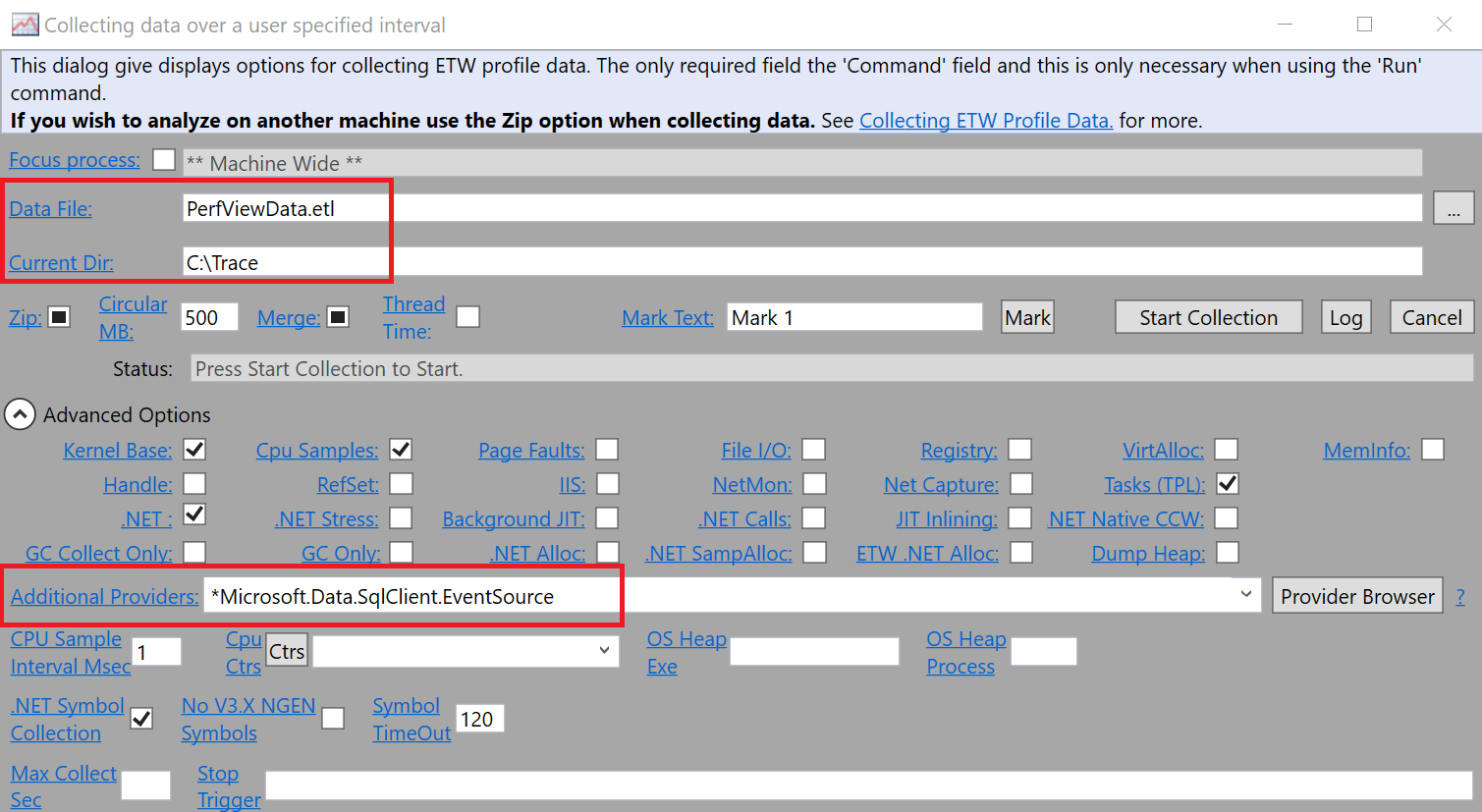启用 SqlClient 中的事件跟踪
适用于: .NET Framework
.NET
.NET Standard
Windows 事件跟踪 (ETW) 是一种高效的内核级别跟踪功能,通过此功能,你可以记录用于调试和测试的驱动程序定义的事件。 SqlClient 支持在不同的信息级别捕获 ETW 事件。 若要开始捕获事件跟踪,客户端应用程序应侦听来自 SqlClient 的 EventSource 实现的事件:
Microsoft.Data.SqlClient.EventSource
| 关键字名称 | 值 | 描述 |
|---|---|---|
| ExecutionTrace | 1 | 启用命令执行前后捕获启动/停止事件。 |
| 跟踪 | 2 | 启用捕获基本应用程序流跟踪事件。 |
| 范围 | 4 | 启用捕获进入和退出事件 |
| NotificationTrace | 8 | 启用捕获 SqlNotification 跟踪事件 |
| NotificationScope | 16 | 启用捕获 SqlNotification 范围进入和退出事件 |
| PoolerTrace | 32 | 启用捕获连接池流跟踪事件。 |
| PoolerScope | 64 | 启用捕获连接池范围跟踪事件。 |
| AdvancedTrace | 128 | 启用捕获高级流跟踪事件。 |
| AdvancedTraceBin | 256 | 启用捕获带有其他信息的高级流跟踪事件。 |
| CorrelationTrace | 512 | 启用捕获关联流跟踪事件。 |
| StateDump | 1024 | 启用捕获完整状态转储 SqlConnection |
| SNITrace | 2048 | 启用从托管网络实现捕获流跟踪事件(仅适用于 .NET Core) |
| SNIScope | 4096 | 启用从托管网络实现捕获范围事件(仅适用于 .NET Core) |
示例
下面的示例对“AdventureWorks”示例数据库上的数据操作启用事件跟踪,并在控制台窗口中显示事件。
using System;
using System.Diagnostics.Tracing;
using Microsoft.Data.SqlClient;
// This listener class will listen for events from the SqlClientEventSource class.
// SqlClientEventSource is an implementation of the EventSource class which gives
// it the ability to create events.
public class SqlClientListener : EventListener
{
protected override void OnEventSourceCreated(EventSource eventSource)
{
// Only enable events from SqlClientEventSource.
if (eventSource.Name.Equals("Microsoft.Data.SqlClient.EventSource"))
{
// Use EventKeyWord 2 to capture basic application flow events.
// See the above table for all available keywords.
EnableEvents(eventSource, EventLevel.Informational, (EventKeywords)2);
}
}
// This callback runs whenever an event is written by SqlClientEventSource.
// Event data is accessed through the EventWrittenEventArgs parameter.
protected override void OnEventWritten(EventWrittenEventArgs eventData)
{
// Print event data.
Console.WriteLine(eventData.Payload[0]);
}
}
class Program
{
public static void Main()
{
// Create a new event listener.
using (SqlClientListener listener = new SqlClientListener())
{
string connectionString = "Data Source=localhost; " +
"Initial Catalog=AdventureWorks; Integrated Security=true";
// Open a connection to the AdventureWorks database.
using (SqlConnection connection = new SqlConnection(connectionString))
{
connection.Open();
string sql = "SELECT * FROM Sales.Currency";
SqlCommand command = new SqlCommand(sql, connection);
// Perform a data operation on the server.
SqlDataReader reader = command.ExecuteReader();
while (reader.Read())
{
// Read the data.
}
reader.Close();
}
}
}
}
本机 SNI 中的事件跟踪支持
Microsoft.Data.SqlClient 在 Microsoft.Data.SqlClient.SNI 和 Microsoft.Data.SqlClient.SNI.runtime(从 v2.1 开始)中提供了事件跟踪支持 。 可使用 Xperf 和 PerfView 工具从本机 DLL 收集事件。
从 Microsoft.Data.SqlClient v3.0 开始,可使用事件收集工具启用事件跟踪,而无需在客户端应用程序中进行任何修改。
对于 Microsoft.Data.SqlClient v2.1,需要通过使用事件源侦听器配置 EventCommand 来启用事件跟踪。 适用于本机 SNI 的有效 EventCommand 值如以下所示:
// Enables trace events:
EventSource.SendCommand(eventSource, (EventCommand)8192, null);
// Enables flow events:
EventSource.SendCommand(eventSource, (EventCommand)16384, null);
// Enables both trace and flow events:
EventSource.SendCommand(eventSource, (EventCommand)(8192 | 16384), null);
下面的示例在本机 SNI DLL 中启用了事件跟踪。
// Native SNI tracing example
using System;
using System.Diagnostics.Tracing;
using Microsoft.Data.SqlClient;
public class SqlClientListener : EventListener
{
protected override void OnEventSourceCreated(EventSource eventSource)
{
if (eventSource.Name.Equals("Microsoft.Data.SqlClient.EventSource"))
{
// Enables both trace and flow events
EventSource.SendCommand(eventSource, (EventCommand)(8192 | 16384), null);
}
}
}
class Program
{
static string connectionString = @"Data Source = localhost; Initial Catalog = AdventureWorks;Integrated Security=true;";
static void Main(string[] args)
{
// Event source listener configuration is not required in v3.0 onwards.
using (SqlClientListener listener = new SqlClientListener())
using (SqlConnection connection = new SqlConnection(connectionString))
{
connection.Open();
}
}
}
使用 Xperf 收集跟踪
使用以下命令启动跟踪。
xperf -start trace -f myTrace.etl -on *Microsoft.Data.SqlClient.EventSource运行本机 SNI 跟踪示例以连接到 SQL Server。
使用以下命令停止跟踪。
xperf -stop trace使用 PerfView 打开在步骤 1 中指定的 myTrace.etl 文件。 可以通过
Microsoft.Data.SqlClient.EventSource/SNIScope和Microsoft.Data.SqlClient.EventSource/SNITrace事件名称找到 SNI 跟踪日志。
使用 PerfView 收集跟踪
启动 PerfView,并从菜单栏运行
Collect > Collect。配置跟踪文件名、输出路径和提供程序名称。

开始收集。
运行本机 SNI 跟踪示例以连接到 SQL Server。
使用 PerfView 停止收集。 根据步骤 2 中的配置,生成 PerfViewData.etl 文件需要一段时间。
在 PerfView 中打开
etl文件。 可以通过Microsoft.Data.SqlClient.EventSource/SNIScope和Microsoft.Data.SqlClient.EventSource/SNITrace事件名称找到 SNI 跟踪日志。
使用 dotnet-trace 收集跟踪
在 Linux、macOS 或 Windows 上,dotnet-trace 可用于捕获跟踪。 donet-trace 工具用于收集 .NET 应用程序的跟踪。 有关 dotnet-trace 的详细信息,请参阅 dotnet-trace 性能分析实用工具。可在 PerfView 中查看 dotnet-trace 创建的跟踪。
如果尚未安装,请在客户端计算机上安装 .NET SDK。
运行 dotnet-trace。
--providers参数要求为 Microsoft.Data.SqlClient 中的跟踪指定提供程序名称和关键字。 关键字选项是转换为十六进制的事件关键字表中关键字值的总和。 若要从应用程序开头的详细级别MyApplication收集所有事件,关键字的总和为 8191,采用十六进制时为1FFF。 通过5在此命令中指定详细级别。dotnet-trace collect --providers Microsoft.Data.SqlClient.EventSource:1FFF:5 -- dotnet MyApplication.dll输出为:
Provider Name Keywords Level Enabled By Microsoft.Data.SqlClient.EventSource 0x0000000000001FFF Verbose(5) --providers Launching: dotnet MyApplication.dll Process : /usr/lib/dotnet/dotnet Output File : /home/appuser/dotnet_20240927_102506.nettrace [00:00:00:00] Recording trace 0.00 (B) Press <Enter> or <Ctrl+C> to exit... Trace completed. Process exited with code '1'.若要在正在运行的应用程序的信息级别收集所有事件,请先查找应用程序的进程 ID。 然后在进程中运行 dotnet-trace。 信息级别由
4指定。dotnet-trace ps 8734 MyApplication /home/appuser/MyApplication/MyApplication dotnet-trace collect -–process-id 8734 --providers Microsoft.Data.SqlClient.EventSource:1FFF:4单独运行应用程序,直到问题重现。 如果是高 CPU,通常 5 - 10 秒就足够了。
Provider Name Keywords Level Enabled By Microsoft.Data.SqlClient.EventSource 0x0000000000001FFF LogAlways(0) --providers Process : /usr/lib/dotnet/dotnet Output File : /home/appuser/dotnet_20240927_104154.nettrace [00:00:00:10] Recording trace 4.096 (KB) Press <Enter> or <Ctrl+C> to exit... Stopping the trace. This may take several minutes depending on the application being traced. Trace completed.跟踪文件名称以
.nettrace结尾。 如果未在 Windows 上跟踪,请将该文件复制到 Windows 系统。 在 PerfView 中查看跟踪文件。
外部资源
有关如何跟踪 Microsoft.Data.SqlClient 跨平台的另一组示例,请参阅 CSS SQL 网络工具 Wiki。
有关事件跟踪的详细信息,请参阅以下资源。
| 资源 | 说明 |
|---|---|
| EventSource 类 | 用于创建 ETW 事件。 |
| EventListener 类 | 提供用于启用和禁用事件源中事件的方法。 |
